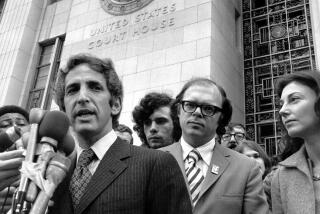Review: ‘Good Spy’ scrutinizes Middle East CIA officer Robert Ames
The collapse last month of America’s latest efforts to broker an Israeli-Palestinian peace deal marked another spin in the relentless cycle of heartache, conflict and terrorism in the Middle East. Arguably no American was more familiar with the region’s tortured dynamics than Robert C. Ames, a legendary CIA officer and Mideast specialist who is the subject of Kai Bird’s engrossing biography, “The Good Spy.”
Bird shared a Pulitzer in 2005 for “American Prometheus,” his magisterial biography of J. Robert Oppenheimer. He brings the same careful scrutiny to Ames, and partly for personal reasons: The son of a U.S. diplomat, Bird had lived as a boy near the Ames’ home in Saudi Arabia. The Birds didn’t know their amiable neighbor was a clandestine CIA officer. But that long-ago link helped persuade Ames’ widow, Yvonne, to share his personal papers. The trove helped Bird pull back layers of secrecy in Ames’ life and reveal a startling series of covert CIA operations and spycraft.
Ames was a Zelig-like figure for America in the Middle East in the 1960s and 1970s, seemingly involved in every crisis, “the closest thing to an irreplaceable man,” as CIA chief Bill Casey said at his memorial.
Others called him an “American Lawrence” of Arabia, a charismatic figure who loved the language, rhythms and politics of the Arab world. But it was also recognition that Israeli intelligence and even some CIA colleagues thought Ames acted as an advocate for the Arabs, especially for the Palestinians.
Ames somehow walked a careful line between espionage and diplomacy for much of his career, and Bird brings us along. Budding Arabists will enjoy details about groups and leaders now barely remembered. Lay readers will enjoy a taut narrative of assassinations and bombings of the era. But this is serious history, not a thriller.
With a wry wit, an amiable mien and a flexible morality, Ames was a natural spy. He studied Arabic in the Army and was assigned to a desert outpost in Saudi Arabia after he joined the CIA in 1960. The CIA still largely relied on oil men for intelligence in the region. But as Ames moved from country to country over the next two decades, he helped expand CIA access and understanding amid the constant tumult. He cultivated emirs and kings, revolutionaries and terrorists.
Most remarkably, he befriended Ali Hassan Salameh, the so-called Red Prince of the Palestine Liberation Organization, then a terrorist group. Salameh was the PLO intelligence chief and was close to PLO chief Yasser Arafat, a figure then almost as infamous as Osama bin Laden would later become. Ames’ superiors repeatedly pressed him to recruit Salameh as an agent and put him on the CIA payroll. Ames refused, and the secret back channel to Arafat stayed open for a decade while Washington insisted it had no contact with the PLO.
In 1976, Ames even arranged for the CIA to pay for Salameh and his mistress, a former Miss Universe, to secretly visit Disneyland, New Orleans and Hawaii. That was four years after Black September, a PLO offshoot, had massacred 11 Israeli athletes at the Munich Olympics, one of many murderous schemes in which Salameh played a role. Yet Ames repeatedly warned Salameh of Israeli assassination plots. The Israelis finally killed Salameh with a car bomb in 1979.
Later that year, after Islamic forces overthrew the U.S.-backed shah of Iran, Ames flew to Tehran. By then, Ames was national intelligence officer for the Near East, a top-ranked position. Over the next few months, Ames and a CIA colleague repeatedly shared U.S. intelligence with supposedly moderate members of the new revolutionary government, hoping to open a line of communication.
The secret outreach backfired when militants seized the U.S. Embassy and took 61 American hostages that October, an attack the CIA also had failed to anticipate. Ames’ contacts in the government were hanged or jailed. In 1980, Ames helped plan the Desert One rescue mission that ended in a debacle when a military helicopter crashed into a transport plane, killing eight U.S. servicemen.
Israel’s 1982 invasion of Lebanon and a massacre by Christian militias of several thousand Palestinians at two refugee camps inflamed the region. Many Arabs directed their rage at the United States. Shortly after noon on April 18, 1983, a black pickup truck roared up the front steps of the U.S. Embassy in Beirut. The massive bomb killed more than 60 people, including Ames, who was visiting. Ironically, a key suspect in his murder, a shadowy killer named Imad Mughniyeh, was once trained and employed by Ames’ friend, Salameh.
Bird argues that Ames’ work as a spy paved the way for the Oslo Accords, the 1993 peace agreement between Israel and the PLO. Had Ames lived, Bird writes, he might have “helped heal the rift between Arabs and the West.”
Perhaps. The Oslo peace process collapsed in 2000 amid fierce new Israeli-Palestinian fighting, and Ames’ legacy is far from clear. This absorbing book suggests that even the best of intentions, and the best of spies, aren’t enough to bridge the chasms in the Middle East.
The Good Spy
The Life and Death of Robert Ames
Kai Bird
Crown: 448 pp., $26
More to Read
Sign up for our Book Club newsletter
Get the latest news, events and more from the Los Angeles Times Book Club, and help us get L.A. reading and talking.
You may occasionally receive promotional content from the Los Angeles Times.









